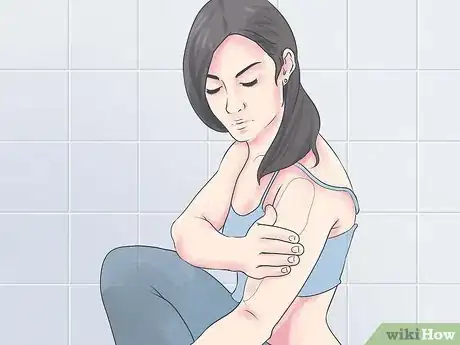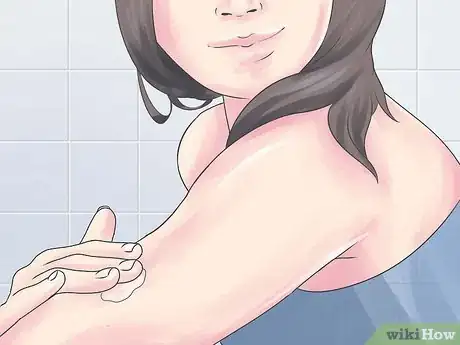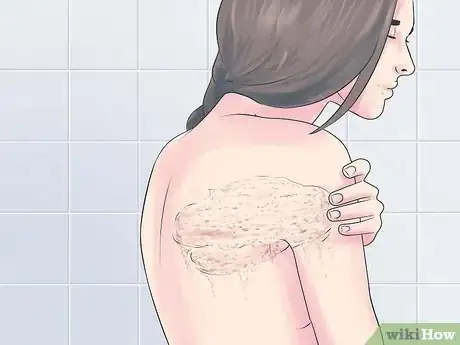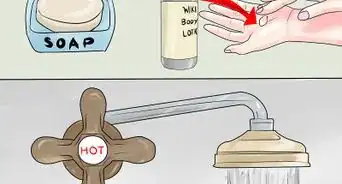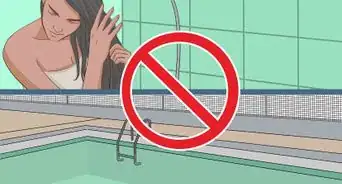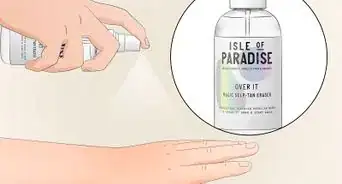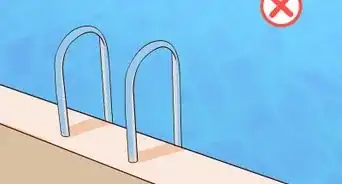This article was co-authored by Mohiba Tareen, MD. Mohiba Tareen is a board certified Dermatologist and the founder of Tareen Dermatology located in Roseville, Maplewood and Faribault, Minnesota. Dr. Tareen completed medical school at the University of Michigan in Ann Arbor, where she was inducted into the prestigious Alpha Omega Alpha honor society. While a dermatology resident at Columbia University in New York City, she won the Conrad Stritzler award of the New York Dermatologic Society and was published in The New England Journal of Medicine. Dr. Tareen then completed a procedural fellowship which focused on dermatologic surgery, laser, and cosmetic dermatology.
This article has been viewed 313,873 times.
Self-tanners have improved since they were first introduced to the market and earned a notorious reputation for producing an orange, streaky color. Incorrect shade selection and errors in application still produce the occasional self-tanning error, though. Although streaks and discoloration will go away in a few weeks once the outer layers of skin slough off, some people who self-tan may not be able to wait for their botched tanning to disappear on its own. There is no way to completely remove self-tanner immediately, but beauty experts recommend some tips to get your old color back as quickly as possible.
Steps
Correcting Small Imperfections
-
1Assess the damage. If your tan is even but too deep or orange-colored, then your removal method will be a little different than if you are dealing with streaks. We'll cover overall tone in the next section if your self-tanner has left you looking less "ooh la la!" and more "oompa loompa." But for now let's concentrate on those patches and unfortunate streaks.
-
2Use lemon. It purportedly gets rid of freckles, right? If it can get rid of permanent marks on your skin, it can definitely get rid of temporary self-tanner. It's best for that random streak, on your palms, or little places you just got a little over-zealous with. There are two ways you can get your lemon on:
- Combine a couple tablespoons of lemon juice with baking soda to form a paste. Slather it over the affected area, leave it on for a few minutes, and wash it off while gently rubbing.
- Cut the lemon in half and rub one section over the affected area. If it's really bad, it may take more than once, but you should see improvements just about automatically.
Advertisement -
3Try whitening toothpaste for the small, uneven patches. Those little crevices between your fingers? A self-tanner's nightmare. To get at those little pesky nooks and crannies, try whitening toothpaste. It has the same bleaching agents in it as everything else, which work on your teeth and skin.
- This obviously works best for small, confined areas. Put a dab on your finger and massage it into the area. Scrub it off and assess your results, repeating if necessary.
-
4Use acetone or rubbing alcohol. Acetone is known as nail polish remover, by the way. Take your cotton ball, saturate it, and rub it over the area. Use this method sparingly, however; the stuff can be quite hard on your skin if used unyieldingly.
- If you do go this route, be sure to moisturize afterward. Your body will be craving the hydration after being exposed to either of those two products.
Correcting Overall Tone
-
1Draw a hot, soapy bath. Choose a time when you are free to soak for at least 1 hour. The more recently you put on your self-tanner, the better; it's a bit harder to take off when it's set. Consider this an excuse for an hour of me time!
- This part is totally optional. Soaking for longer can loosen your self-tanner's jaws, but exfoliates and toners work by themselves, too.
-
2Exfoliate with a dermatologist approved sugar scrub. If you don't have one, you can make one yourself! The sugar beads lift up your top layer of skin, greatly reducing that unfortunate color you've acquired. And it leaves your skin silky smooth!
- Use an exfoliating mitt to expedite the process and double your efficacy. A pumice stone is generally to hard on your skin, so it's best to stick to the mitt or your loofah.
- Then apply a gradual self-tanner, if you'd like. You know, one of the kinds that is purposefully slow-going. It can help even out what's left of your original experience.
-
3Douse yourself in baby oil for an overall tone reduction. The longer you can keep it on the better, but aim for at least 10 minutes. 30 if you can tolerate the boredom of just standing there! This is a good method if you're just too dark or too orange, as it will reduce the difference between your natural tone and your tanned tone overall.[1]
-
4Apply a strong toner to your face, neck, hands and feet before bedtime. These will be your biggest priorities, since they can't be easily covered with clothing. They are also resilient areas that are not prone to irritation when a toner is used.
- If you have a toner with alpha hydroxy acids (AHAs) or beta hydroxy acids (BHAs), use it. These acids tend to be very effective at correcting skin discoloration.
-
5Use self-tanner remover. Yep, there's definitely such a thing and they generally cost around $15. They come in the forms of pads or creams and are pretty self-explanatory.
- They'll be effective, but not necessarily any more so than the stuff you already have in your bathroom/kitchen. Only shell out the bills if for some reason you feel compelled to.
-
6Assess your skin color when you wake up in the morning. You should notice significant improvement, but if you still see some discoloration or streaks, continue with regular baths, baking soda scrubs and lemon juice and toner applications. No self-tanner is that permanent; it'll just take some diligence!
Community Q&A
-
QuestionHow do I fade out a fake tan in the fall while keeping it realistic?
 Community AnswerUse the acetone or rubbing alcohol methods once, which will fade the color, and be sure to moisturize daily.
Community AnswerUse the acetone or rubbing alcohol methods once, which will fade the color, and be sure to moisturize daily.
Warnings
- Never use harsh chemicals that aren't intended to be applied topically. These include hydrogen peroxide, household bleach, and stain removers meant for clothing.⧼thumbs_response⧽
References
About This Article
To remove small, uneven patches of self tanner, apply whitening toothpaste, rubbing alcohol, or acetone nail polish remover to the area and follow up with a good moisturizer. If you need to remove large areas of self tanner, try soaking in a warm bath for about an hour, then exfoliate your skin with a gritty scrub. You can also apply a strong toner to your face, neck, hands, and feet to counteract some of the damage. If home remedies aren't working, consider trying a store-bought self tanner remover to get rid of the unwanted color. For tips on using lemon juice and baking soda, read on!
